THE standard CLEANING PROCESS & WHAT WE USE
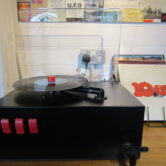
Stage 1 – MOTH MKII RECORD CLEANING MACHINE
The MKII Moth Machine is based upon the well proven and accepted record cleaner that has been available from Moth for around 20 years. Record cleaning machines have long been accepted as one of the most effective and efficient ways of cleaning and renovating vinyl LP’s, 12”, 10” and 7” singles, and even some 78’s.
The MKII Moth Record Cleaning machine is a wet cleaning and vacuum removal device, with a powered turntable which allows for bi-directional operation of the turntable in both the fluid application ‘Wash’ cycle and in the vacuum ‘Drying’ phase, with a drainable internal reservoir to collect waste fluid from the vacuumed record surface. Fluid is applied by hand to a rotating record, then brushed, and then drawn off the record by a high efficiency vacuum system.
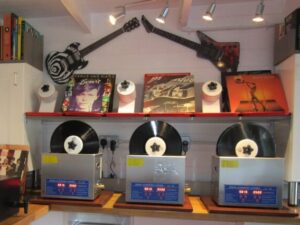
Stage 2 – ULTRASONIC CLEANING MACHINE / WATER BATH
Our ultrasonic cleaner is a device that cleans items by using ultrasound and water or an appropriate cleaning solvent. It offers complete and rapid removal of dirt, germs and other contaminants from items that are placed in a tank of water, that is then agitated with sound waves having a high frequency.
When the machine is switched on, it activates an internal transducer which converts the electrical energy to ultrasonic energy. It does this as the transducer increases in size to create high-frequency compression sound waves, which results in the rapid formation and collapse of cavitation bubbles.
Compression waves continue and the cavitation bubbles grow larger, and when they reach a certain size and can’t retain their shape any longer, the bubbles stir through the liquid, turning the liquid apart. These bubbles are what impacts against the objects in the tank, causing dust, dirt, germs, oil, pigments, and other contaminants that might have stuck to the items to come off.
Vinyl Records are normally cleaned for up to 5 -10 minutes, and longer if necessary.
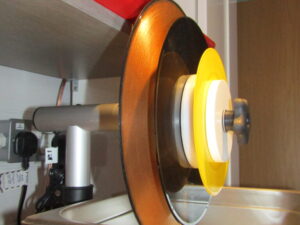
Stage 2 – VINYL STACK ULTRA SONIC SPIN KIT
The Vinyl Stack Ultra Sonic Spin Kit is what we use to clean multiple vinyl records at a time, within our Ultrasonic Cleaning baths machines. Using the Sonic Spin ‘3’ and ‘4’ Stack Record Label Protector units which attach to individual motorised Ultra Sonic Spin unit, your record labels stay dry and protected, while your record slowly rotates, bathes and cleans within the bath.
The Ultra Sonic Spin unit is fitted with a variable speed DC motor, which allows for precise and extremely slow rotation (between 1.5 – 7 minutes per revolution) of your records, resulting in optimal deep ultrasonic cleaning.
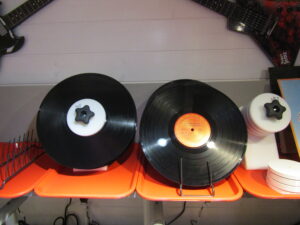
Stage 3 – DRYING TIME & FINISH
Following the bathing process, we allow for adequate drying of your records on our drying racks, before a final wipe down with micro-fibre cloth, and then a final inspection to make sure your record is cleaned and dry, before being Anti-Static treated and then returned to its original inner sleeve, or a new inner sleeve which is recommended and at additional cost.
The drying time is monitored closely so that your records are not returned to their sleeves too early and therefore still damp, to prevent possible mildew and attraction of future contaminants. Further, we do not want to leave your records out in the open atmosphere too long on the drying racks either, as this will start the dust attraction process to the record surface, again.
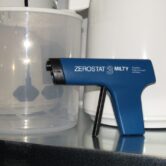
Stage 4 – ZEROSTAT 3 ANTI-STATIC GUN
The Zerostat 3 is a device that produces a combination of positive and then negative ions at the ‘target’, your vinyl records.. The idea is to neutralise the area of static charge, the thing that attracts dust to the area.
It removes static electricity from the surface of the record, helping to prevent dust infiltrating its grooves and creating noisy playback. If you’ve ever taken a record out of a sleeve and heard multiple cracks from static as the LP is removed, this means that your vinyl is covered in static electricity and is currently attracting dust to its grooves, even inside the sleeve and when it hits open air, and then when you put it on the turntable and while it’s playing. The result is more noise during play, and because dust erodes, that dust will increase wear and tear on the vinyl itself. Yes that will take a long time, but the effect will hasten your record’s playability and sound quality.
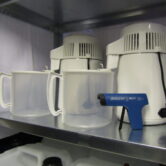
We only use Distilled water which is distilled and produced in-house, from our filtered water system, to use in our Ultrasonic bathing/ cleaning machine process. This allows us to be as Eco-Friendly to your records and to the environment as practicable.
Using Distilled water is slightly less effective (about a third) than using Deionised water in the cleaning process, but it is a less harmful way of obtaining Distilled water than the production of Deionised, which uses chemicals within filtration resins in its production. Distilled water is then free of minerals and salts, and also virus and bacteria free.
This makes it easy to dispose of the dirty waste water, through a fine filtration process and further water distillation, for clean recyclable use.
We use a small diluted amount of specialist cleaning fluid in the Moth MKII Cleaning Machine process as part of the recommended Moth cleaning procedure. Any extra cleaning fluid that is not vacuumed up in this process is gently removed with micro-fibre cloth, immediately on completion and before the Ultrasonic bathing process.
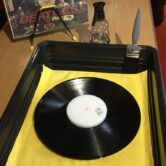
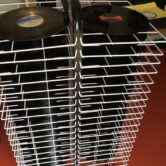
THE PREMIER CLEANING PROCESS
The Premier Cleaning method is a more timeous process than Standard. Each side of the record playing surface is first coated with a mix of distilled water with a precise measure of Surfactant. This is a substance which reduces the surface tension of a liquid in which it is dissolved, which then soaks deep into the record groove. This allows for the deepest penetration of our cleaning fluids in the Moth Mk II vacuum and Ultrasonic bathing processes.
Each record playing surface (and not the label) is gently coated with this liquid with a fine brush, and then left to dry on a drying rack, before then repeating the process of the opposite side. Drying can take approx. 1-2 hours for each side dependant on ambient room temperature.
When this is completed, the records are then cleaned and processed in the exact same manner as the Standard cleaning method, using the Moth Mk II vacuum, Ultrasonic bathing and Zerostat 3 antistatic application.
I consider this cleaning method to be the very best and most effective process for cleaning your oldest and most played vinyl. Since these are likely to be the most handled (with sweaty finger prints, etc.) and over time more atmospherically exposed, the dirtier these records will be.